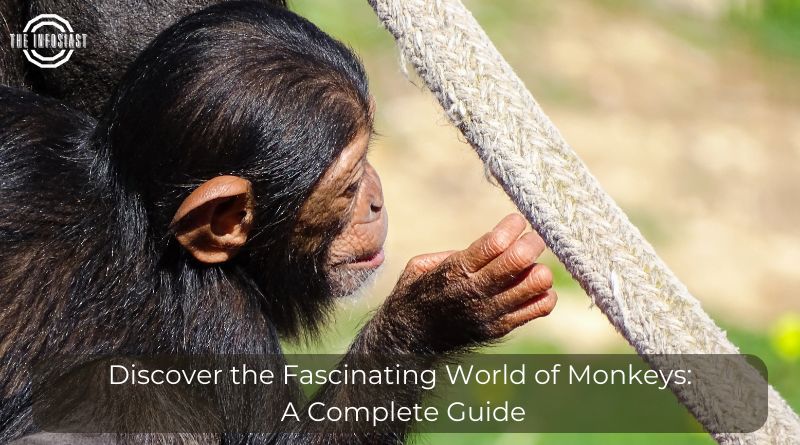
Welcome to the captivating world of monkeys! These intelligent and curious creatures have been a source of wonder and inspiration for humans for centuries. In this comprehensive guide, we will delve into the diverse species of monkeys, their behavior, habitat, and fascinating facts. Whether you are a wildlife enthusiast, a student, or simply intrigued by these primates, this article will provide you with all the information you need to satisfy your curiosity about monkeys.
The Diversity of Monkeys:
Monkeys belong to the primate order and are classified into two broad categories: New World monkeys and Old World monkeys. New World monkeys are found in the Americas, while Old World monkeys inhabit Africa and Asia. There are over 260 known species of monkeys, each with unique characteristics and adaptations that make them stand out in the animal kingdom.
Monkey Behavior and Social Structure:
Monkeys are highly social animals, and their interactions within groups are both intricate and fascinating. They form close-knit communities, relying on social bonds to thrive. Within these groups, you will find complex hierarchies, with dominant and subordinate individuals. Observing their interactions can often remind us of our own social dynamics.
Monkey Habitats:
Monkeys have adapted to a wide range of habitats, from lush rainforests to arid savannas. New World monkeys are agile tree-dwellers, while some Old World monkeys have evolved to be ground-dwellers. Their ability to adapt to different environments has contributed to their widespread distribution across the globe.
Surprising Monkey Facts:
Let’s delve into some fascinating facts about monkeys that will surely leave you amazed. Did you know that Capuchin monkeys are adept at using tools, such as stones to crack nuts? Or that the Mandrill has the most colorful face of any mammal, making it a sight to behold in the wild? These intriguing details showcase the diversity and intelligence of these incredible creatures.
The Importance of Monkey Conservation:
While monkeys continue to capture our hearts with their charm, they are also facing various threats in the wild. Deforestation, habitat loss, and illegal wildlife trade pose significant challenges to their survival. As responsible stewards of the Earth, it is crucial for us to support conservation efforts and protect these marvelous creatures for future generations to appreciate.
“Monkeys as Therapy Animals: Enhancing Lives with Primate Companionship”
Monkeys, with their lively and intelligent nature, have been recognized for their therapeutic value in various settings. From providing emotional support to individuals with special needs to assisting in rehabilitation, monkey companionship has shown to have a positive impact on human lives. In this article, we explore the heartwarming stories of how monkeys have become therapy animals, spreading joy and healing in unexpected ways.
Monkey-Assisted Therapy:
Monkey-assisted therapy has gained popularity in recent years, particularly in assisting individuals with physical and emotional challenges. Capuchin monkeys, in particular, have been trained to aid people with mobility issues. These clever monkeys can fetch items, open doors, and even help with simple household tasks, empowering individuals to lead more independent lives.
Emotional Support Monkeys:
Monkeys’ ability to form strong emotional bonds makes them excellent candidates as emotional support animals. They provide companionship and comfort to those struggling with anxiety, depression, or post-traumatic stress disorder (PTSD). Their presence can significantly reduce stress and anxiety, offering a unique form of solace to their human companions.
Monkeys in Educational Settings:
Bringing monkeys into educational environments has proven to be beneficial for children with learning disabilities. The presence of these curious creatures can foster engagement, encourage communication, and create a positive atmosphere for learning. Educators have witnessed remarkable improvements in students’ social skills and overall motivation.
Monkey-Human Connection:
The bond between monkeys and humans is both heartwarming and profound. Many therapy animal owners share heart-touching anecdotes of how their primate companions have brought purpose and joy into their lives. These stories highlight the therapeutic power of unconditional love and acceptance that monkeys offer to those in need.
Responsible Monkey Companionship:
While the idea of having a therapy monkey might seem appealing, it is essential to remember that monkey care requires specialized knowledge and commitment. Monkeys are highly intelligent and require a stimulating and enriching environment. Organizations specializing in primate therapy and support can guide individuals interested in having a monkey companion responsibly.
Conclusion:
In conclusion, exploring the world of monkeys has opened our eyes to the wonder and beauty of nature. From their diverse species and intricate social structures to their incredible adaptability and surprising facts, monkeys are a treasure trove of fascination. Let us stand united in conserving their habitats and ensuring a thriving future for these remarkable creatures. The more we understand and appreciate monkeys, the better equipped we are to coexist with them and other precious wildlife on our planet. The stories of monkeys transforming lives as therapy animals underscore the extraordinary potential these creatures possess to make a positive impact on human well-being. From assisting with daily tasks to providing emotional support, their unique abilities have touched the hearts of many. As we embrace the therapeutic potential of monkeys, it is crucial to approach monkey-human partnerships with responsibility and respect, ensuring the well-being of both humans and these remarkable primate companions.



